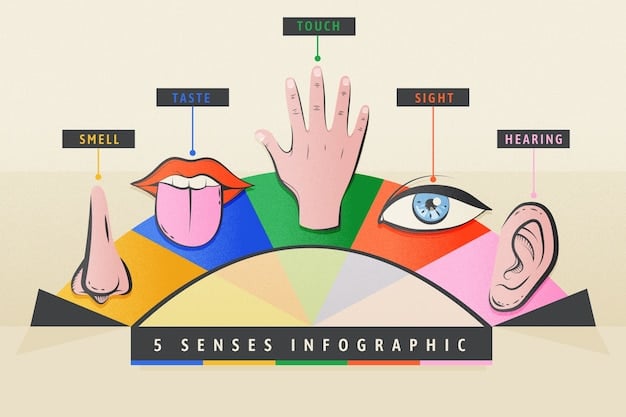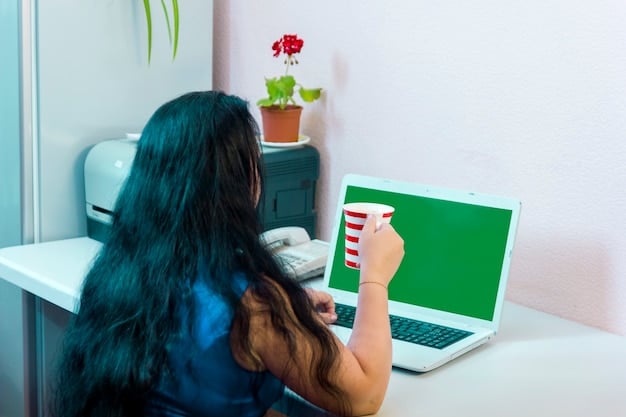Boost Exam Scores by 15% in 3 Months: Know Your Learning Style

Understanding your learning style can significantly enhance your study efficiency, potentially increasing exam scores by up to 15% within three months by tailoring your study methods to suit your individual cognitive strengths.
Are you struggling to improve your exam scores despite putting in the hours? The secret might lie in understanding your learning style. Discover how does understanding your learning style increase exam scores by 15% in 3 months by tailoring your study habits to your strengths.
Understanding Learning Styles: A Quick Overview
Learning styles are the different ways people process and retain information. Recognizing your preferred style can transform how you study, making it more effective and enjoyable. Let’s delve into what learning styles are and why they matter.
What are Learning Styles?
Learning styles refer to the idea that individuals learn differently. These styles categorize learners into groups based on how they best absorb, process, comprehend, and retain information.
Why are Learning Styles Important?
Recognizing your learning style allows you to tailor your study techniques to fit your cognitive strengths. This can lead to improved focus, better retention, and increased efficiency in your studies. By using methods that align with your learning preferences, you can unlock your full academic potential.
- Improved Study Efficiency: Tailoring study methods to your learning style can save time and effort.
- Increased Retention: Information is more likely to stick when learned in a way that suits you.
- Enhanced Motivation: Studying becomes more engaging when you use methods you enjoy.
Understanding learning styles isn’t just about making studying easier; it’s about optimizing your cognitive processes to achieve better academic results. Recognizing and adapting to these styles can be a game-changer for students.

The Three Main Learning Styles
There are several models of learning styles, but the most widely recognized categorizes learners into three main types: visual, auditory, and kinesthetic. Understanding each of these can help you identify which one resonates most with you. Let’s explore each style in detail.
Visual Learners
Visual learners learn best through seeing. They benefit from diagrams, charts, videos, and written information. Visual aids help them understand and remember complex concepts.
Strategies for visual learners include using mind maps, flashcards with images, and watching educational videos. Color-coding notes and creating visual timelines can also enhance their learning experience. A visual learner often thrives when information is presented in a structured and visually appealing way.
Auditory Learners
Auditory learners excel when information is heard or spoken. They prefer lectures, discussions, and audio recordings. Hearing the material helps them process and retain it effectively.
Methods that work well for auditory learners include participating in group discussions, recording lectures and listening to them later, and reading aloud. Explaining concepts to others and using mnemonic devices can also be beneficial. The key for auditory learners is to engage their sense of hearing to reinforce learning.
Kinesthetic Learners
Kinesthetic learners learn best through physical activities and hands-on experiences. They prefer doing things rather than just reading or hearing about them. Active involvement is crucial for their learning process.
- Hands-on Activities: Engaging in experiments, simulations, and real-world applications.
- Movement and Breaks: Incorporating movement into study sessions and taking frequent breaks to stay focused.
- Role-Playing and Demonstrations: Acting out concepts and physically demonstrating understanding.
Kinesthetic learners benefit from activities such as building models, doing experiments, and using tactile aids. Taking notes while walking, using flashcards while moving, and engaging in role-playing can also improve their retention. The more active and involved they are, the better they learn.
Identifying Your Dominant Learning Style
Discovering your dominant learning style is the first step toward optimizing your study habits and improving your exam scores. There are several ways to identify your learning style, from self-assessment questionnaires to observing your study habits. Let’s explore some effective methods.
Self-Assessment Questionnaires
Many online questionnaires can help you determine your learning style. These assessments typically involve answering a series of questions about your preferences and behaviors. The results provide insights into which learning style you most closely align with.
These questionnaires are designed to be quick and intuitive, making them an accessible starting point for self-discovery. While they may not be definitive, they offer valuable guidance in understanding your learning preferences.
Observing Your Study Habits
Pay attention to how you naturally approach learning tasks. Do you prefer reading textbooks, listening to lectures, or engaging in hands-on activities? Your natural tendencies can reveal your dominant learning style.
Consider what makes learning enjoyable and effective for you. Do you find it easier to remember information when it’s presented visually, aurally, or kinesthetically? Reflecting on your study habits can provide valuable clues about your learning style.
- Note-Taking Preferences: Do you prefer drawing diagrams, writing detailed notes, or recording lectures?
- Study Environment: Do you study best in a quiet room, a collaborative setting, or while moving around?
- Memory Techniques: Do you remember information better through visual cues, auditory repetition, or physical activities?
By observing your study habits and preferences, you can gain a deeper understanding of your learning style. This self-awareness is crucial for tailoring your study methods and maximizing your academic potential.

Adapting Your Study Habits to Your Learning Style
Once you’ve identified your dominant learning style, the next step is to adapt your study habits accordingly. This involves incorporating strategies that align with your learning preferences to enhance your understanding and retention. Let’s explore how to tailor your study habits to each learning style.
Strategies for Visual Learners
Visual learners benefit from strategies that emphasize visual aids and representations. Incorporating these techniques into your study routine can significantly improve your learning outcomes.
Use mind maps to organize information visually, create flashcards with images to aid memory, and watch educational videos to reinforce concepts. Color-coding notes and creating visual timelines can also enhance your study experience. By focusing on visual representations, visual learners can optimize their understanding and retention of information.
Strategies for Auditory Learners
Auditory learners thrive when information is heard or spoken. Adapting your study habits to incorporate auditory techniques can enhance your learning and retention.
Participate in group discussions to engage with the material aurally, record lectures and listen to them later to reinforce learning, and read aloud to process information effectively. Explaining concepts to others and using mnemonic devices can also be beneficial. The key is to involve your sense of hearing to solidify understanding.
Strategies for Kinesthetic Learners
Kinesthetic learners learn best through physical activities and hands-on experiences. Adapting your study habits to include kinesthetic techniques can transform your learning process.
- Incorporate Movement: Take breaks to move around and stay focused.
- Hands-on Projects: Engage in activities that involve physical interaction with the material.
- Role-Playing and Demonstrations: Physically act out concepts to deepen understanding.
Engage in hands-on activities, take notes while walking, and use flashcards while moving to stay active. Build models and conduct experiments to reinforce learning through physical interaction. By incorporating movement and hands-on experiences, kinesthetic learners can optimize their learning and retention.
Measuring the Impact: Tracking Your Exam Scores
To determine whether understanding your learning style is effectively improving your exam scores, it’s important to track your progress. By monitoring your scores and adjusting your study habits as needed, you can maximize the benefits of this approach. Let’s explore how to measure the impact of adapting your study habits.
Establishing a Baseline
Before implementing new study strategies, establish a baseline by recording your current exam scores. This will serve as a reference point for comparison after you’ve adapted your study habits to your learning style.
Keep track of your scores over several exams to get an accurate representation of your current performance. This baseline will help you assess the effectiveness of the new strategies you implement.
Monitoring Progress
After adapting your study habits, regularly monitor your exam scores to track your progress. Note any improvements and identify areas where you may still be struggling.
Use a spreadsheet or notebook to record your scores and make note of any changes in your study routine. This will allow you to analyze the impact of your new strategies and make adjustments as needed.
- Regular Assessments: Take practice exams and quizzes to gauge your understanding.
- Feedback Analysis: Review feedback from instructors to identify areas for improvement.
- Adjustments: Adapt your study habits based on your progress and challenges.
By consistently monitoring your progress and making adjustments as needed, you can optimize your study habits and achieve significant improvements in your exam scores. This iterative process is key to maximizing the benefits of understanding and adapting to your learning style.
Long-Term Benefits of Understanding Your Learning Style
Understanding your learning style offers benefits that extend far beyond improved exam scores. By recognizing how you learn best, you can enhance your overall academic performance, develop lifelong learning skills, and boost your confidence. Let’s explore the long-term advantages of knowing your learning style.
Enhanced Academic Performance
Adapting your study habits to your learning style can lead to significant improvements in your academic performance. You’ll be able to learn more effectively, retain information better, and achieve higher grades.
By tailoring your study methods to align with your cognitive strengths, you can unlock your full academic potential and excel in your studies. This can open doors to new opportunities and enhance your future prospects.
Lifelong Learning Skills
Understanding your learning style equips you with valuable lifelong learning skills. You’ll become more adaptable, resourceful, and self-directed in your approach to learning.
These skills are essential for continuous growth and development throughout your life. Whether you’re pursuing further education, advancing in your career, or exploring new interests, knowing how you learn best will empower you to succeed.
- Adaptability: Adjust your learning strategies to suit different situations and subjects.
- Resourcefulness: Seek out resources and opportunities that align with your learning style.
- Self-Direction: Take ownership of your learning and set goals that reflect your individual needs and aspirations.
By developing these lifelong learning skills, you’ll be well-equipped to navigate the challenges and opportunities of a rapidly changing world. Understanding your learning style isn’t just about improving your exam scores; it’s about empowering you to become a more effective and confident learner for life.
| Key Point | Brief Description |
|---|---|
| 💡 Learning Styles | Different ways people process and retain information. |
| 👂 Auditory Learning | Learning through listening and speaking. |
| 👁️ Visual Learning | Learning through seeing and observing. |
| 🖐️ Kinesthetic Learning | Learning through hands-on activities. |
Frequently Asked Questions
▼
The main learning styles are visual, auditory, and kinesthetic. Visual learners prefer using images and diagrams, auditory learners learn best through sound, and kinesthetic learners prefer hands-on experiences.
▼
You can identify your learning style through online questionnaires, self-assessment, and observing your study habits. Consider what methods make learning most enjoyable and effective for you.
▼
Understanding your learning style enables you to tailor your study techniques, improving focus, retention, and efficiency. This leads to better academic results and a more enjoyable learning experience.
▼
Yes, adapting your study habits to match your learning style can significantly improve your exam scores. By aligning your study methods with your strengths, you can enhance understanding and retention.
▼
Strategies for visual learners include using mind maps, flashcards with images, watching educational videos, color-coding notes, and creating visual timelines to reinforce learning.
Conclusion
Understanding your learning style is a powerful tool that can transform your academic journey. By identifying your preferred learning method and adapting your study habits accordingly, you can unlock your full potential and achieve significant improvements in your exam scores and overall academic performance. Embrace your learning style and pave the way for a more successful and fulfilling educational experience.





